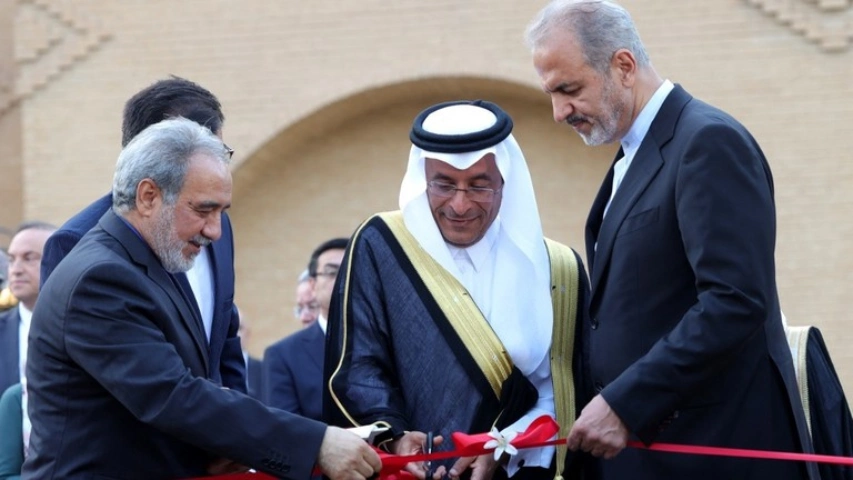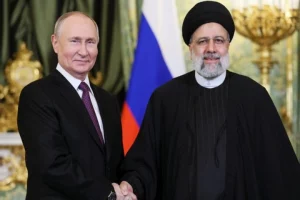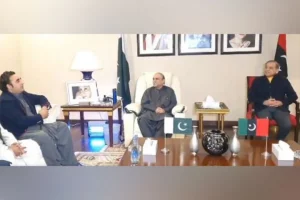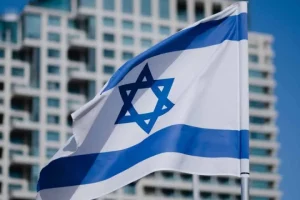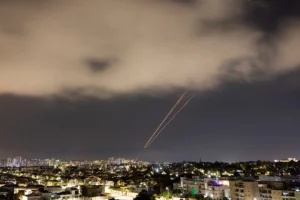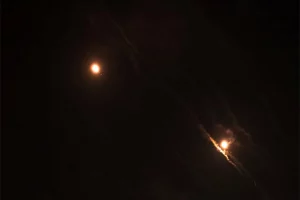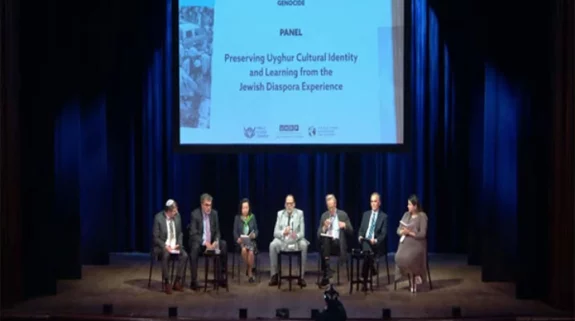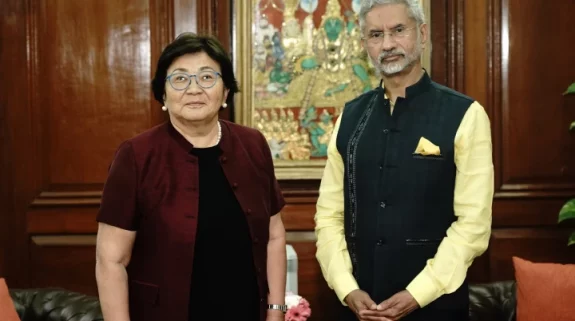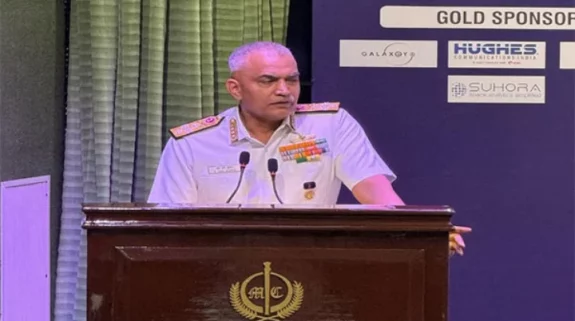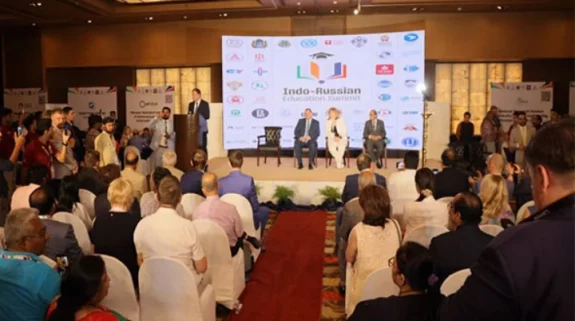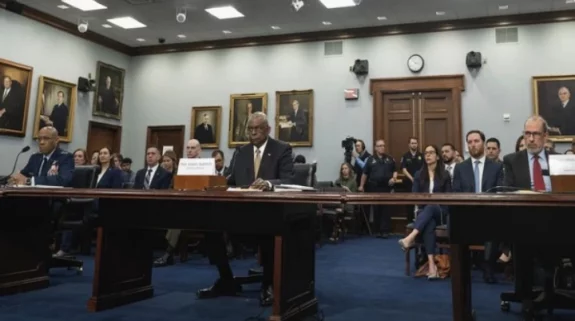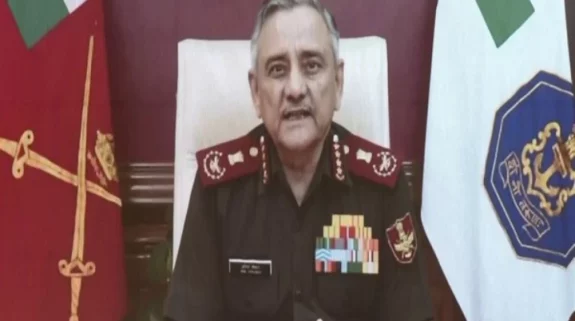Three months after the announcement of the Beijing Accord that, with Chinese mediation, normalised relations between Iran and Saudi Arabia after a seven-month hiatus, West Asia continues to exude optimism about the prospects for peace in the region.
There has been a flurry of visits between the two Gulf neighbours that have led to the re-opening of their respective diplomatic missions. Iran has also extended an invitation to the Saudi monarch, King Salman bin Abdulaziz, to visit Tehran. Iran’s finance minister, Ehsan Khandouzi, visited Jeddah in early May and called for the setting up of a joint Iran-Saudi Arabia chamber of commerce and a bilateral trade target of $1 billion.
The Iranian embassy in the Saudi capital reopened today, after 7 years.#Iran#SaudiArabia pic.twitter.com/x4IixjPs6l
— IRNA News Agency (@IrnaEnglish) June 6, 2023
The first impact of the Beijing Accord regionally is being felt in Yemen. Ending the war in Yemen has been a priority concern for Saudi Arabia and a major driver of the engagement with Iran, seen as the Houthis’ principal ally and supplier of military equipment, including missiles and drones that have wreaked such havoc within the kingdom.
Possibly encouraged by Iranian assurances of reducing military supplies and supporting dialogue, Saudi and Houthi officials met in Sanaa on 9 April, in the presence of Omani mediators. These interactions were taking place in the background of the ceasefire that has been in place for a year. According to reports, the Saudi side have proposed a six-month ceasefire, to be followed by negotiations over three months to discuss the two-year transition phase when the final settlement of outstanding political issues will be discussed. The Saudis have also agreed to pay the salaries of all public employees, including those in Houthi-controlled areas, and to lift the blockade on Yemeni ports.
Exclusive: A Saudi-Omani delegation is planning to travel to Yemen’s capital Sanaa next week to hash out a permanent ceasefire deal with Houthi officials and end the country’s eight-year-old conflict, two sources involved in the talks said https://t.co/HiP4An9dtu
— Reuters (@Reuters) April 7, 2023
Other positive interactions are also taking place in the region. The Iranian Minister of Roads and Urban Development, Mehrdad Bazrpash, visited the UAE in early May to promote economic ties; this includes setting up a direct container line between Jebel Ali and Bushehr and expanding civil aviation links and trade relations.
Separately, the UAE announced on 31 May that it had withdrawn two months earlier from the US-led Combined Maritime Forces, a 34-nation task force, based in Bahrain, that handles maritime security issues in the Gulf and the Red Sea. The withdrawal is believed to be due to US-UAE differences on how to handle the seizure of oil tankers by Iran in the Gulf. The UAE rejected US criticisms as a “mischaracterisation”; it withdrew from the task force saying that this decision was based on UAE’s “ongoing evaluation of effective security cooperation with all partners”.
In an exclusive interview with Press TV, Iran’s Foreign Minister @Amirabdolahian said that Iran and Saudi Arabia will reopen their embassies and consulates in Tehran, Mashhad, Riyadh, and Jeddah.
Amir-Abdollahian added that he and his Saudi counterpart will meet in Tehran in… pic.twitter.com/0ICNKKabtC
— Press TV (@PressTV) June 5, 2023
At the same time, reflecting the changed regional environment after the Beijing Accord, Iran has spoken of a “naval alliance” of Iran, Saudi Arabia, the UAE, Bahrain and Qatar and later bring in Iraq, India and Pakistan.
Visit of the Omani sultan
An important regional engagement has been the visit to Tehran of the Omani ruler, Sultan Sayyid Haitham bin Tariq Al Said on 28-29 May. While the two countries already have substantial political and economic ties, the sultan’s visit had a special significance in that it revived Oman’s role as a mediator to address differences among regional states.
Sayyid Ali Khamenei receives Sultan of Oman Haitham bin Tariq Al Said and his accompanying delegation#Iran #Oman #Imam_Khamenei pic.twitter.com/BjikG8kObS
— Alkhanadeq English (@alkhanadeq_en) May 29, 2023
Sayyid Haitham reached Tehran after a visit to Cairo and conveyed to Supreme Leader Ayatollah Ali Khamenei Egypt’s willingness to restore ties with Tehran that were cut four decades ago after the Islamic Revolution. Khamenei welcomed this initiative, saying that Iran had “no issues in this regard”.
These positive remarks follow the behind-the-scenes dialogue that took place in Baghdad in mid-May between Iranian and Egyptian officials. An Iranian foreign ministry spokesman said that “the region needs synergy between Iran and Egypt”. An Egyptian commentator said that improvement of relations was contingent on Iran’s “good-neighbour approach” especially towards Saudi Arabia, affirming the catalytic role being played by the Beijing Accord to promote de-escalation across the region.
The other message that Sayyid Haitham is believed to have carried is from the US. After the sultan’s visit to Iran, reports from the US said that, on 8 May, President Biden’s adviser on West Asia, Brett McGurk, had undertaken an unreported visit to Muscat where he had discussed a “possible diplomatic outreach to Iran regarding its nuclear programme”.
Brett McGurk, President Biden’s senior Middle East adviser, took a low-profile trip to Oman earlier this month for talks with Omani officials on possible diplomatic outreach to Iran regarding its nuclear program. @BarakRavid https://t.co/ZbSgAhnRrn pic.twitter.com/D8ZP9iKSlu
— Mete Sohtaoğlu (@metesohtaoglu) May 30, 2023
As of now, the Americans appear to be floating the idea of an interim agreement with Iran on the nuclear issue in terms of which Iran will freeze parts of its weapons programme and obtain some sanctions relief. One idea being mentioned in this context is for South Korea to release the $7 billion Iranian funds it holds for earlier oil imports from Iran.
Since reports relating to McGurk’s visit to Muscat have appeared, several media outlets have speculated about the sultan carrying US messages to Iran. This recalls the role played by Oman in hosting US-Iranian talks in the run-up to the Joint Comprehensive Plan of Action (JCPOA), the nuclear agreement that was finalised between Iran and the P5+1 nations in 2015.
Thus, the reverberations of the Beijing Accord are impacting West Asian issues as also matters that have global implications.
The outreach to Syria
Even as the ground was being prepared in Arab capitals in early May for the participation of Syrian President Bashar al-Assad in the Arab League summit in Jeddah on 19 May, Iran’s president, Ebrahim Raisi visited Damascus a few days earlier, on 3-4 May, the first visit of an Iranian president to Syria since 2010. He signed cooperation agreements in the areas of energy, agriculture, transport and civil aviation, communications and IT, banking, and technical and engineering services. He also met leaders of the Palestinian resistance groups – Hamas and Islamic Jihad.
The joint statement praised China’s role in mediating Saudi-Iran relations and the improvement of Syria’s ties with the Arab world. The statement also criticised the “illegal presence of military forces” in Syria, a reference to US soldiers still in northeast Syria, Israeli attacks on Syrian targets, and US and European sanctions on Iran and Syria.
The visit was marked by considerable symbolic value. In a speech at the shrine of Sayyida Zaynab, President Raisi noted that Iran and Russia had backed President Assad from 2012 and, thus, Syria’s victory was the victory of the “resistance axis” against the alliance that had included the US and Israel. (Given the rapprochement between Saudi Arabia and Iran after the Beijing Accord, the kingdom was not included in this list.) Iran was clearly signalling that, despite al-Assad’s rehabilitation in Arab counsels, its own leverage in Syria remains supreme.
Bashar al-Assad landed in Jeddah on 18 May, described by an Arab commentator as “his most triumphant moment on the Arab stage”. Next day, he addressed other Arab leaders at the Arab League summit where he attacked Israel and Turkey and called for “a new stage of Arab action for solidarity between us, for peace in the region”.
Despite US opposition, Syria has been integrated into the Arab fold.
Ties with Russia and China
Shunned by the west as a pariah state, sharply criticised by western media and academia for its “malign” and “malevolent” conduct, and crippled by ever-increasing sanctions, Iran has shifted from its core policy of “Neither East nor West” towards building substantial relations with Russia and China.
The negotiations that led to the JCPOA in 2015 were the last major Iranian effort to engage with the west, put behind the nuclear issue that had divided them, and look towards integrating itself in regional affairs and having substantial political and economic ties with western and eastern powers. Donald Trump’s unilateral withdrawal from the JCPOA in 2018, the imposition of even more harsh sanctions from 2019, and the total inability of European states to revive the agreement and/ or ameliorate the impact of the sanctions ended the influence of officials in Iran who backed engagement with the west. This was marked by the shift in power from Rouhani and his associates to the presidency of Ebrahim Raisi and his hardline colleagues.
Russia, itself subject to western sanctions from 2014 after the annexation of Crimea, has been a natural partner for the Islamic Republic. Trade ties between them have gradually expanded and, in 2022, stood at $4.6 billion, a 15 percent increase over the previous year. Russia is also a major investor in Iran’s energy sector – last year, Russia’s Gazprom, in a $40 billion deal, contracted to develop two of Iran’s gas fields, six oil fields, and provide pipelines and other infrastructure.
Iran 🇮🇷 plans to become a gas hub in the region given the country’s proper geographical situation and its 33 trillion cubic meters of extractable gas. “Through cooperation with Russia 🇷🇺, Turkmenistan 🇹🇲 and Qatar 🇶🇦, Iran is trying to have a gas hub in… https://t.co/YjZbPAtG17 pic.twitter.com/flRY9c4zQE
— The Paradigm Shift – Economics/Geopolitics/Farming (@FertilizerMkts) June 9, 2023
In September 2022, Iran began buying 3.3 billion cubic metres of natural gas from Russia, while in February and March this year, Russia supplied gasoline and diesel to Iran. Again, in January this year, Iran and Russia agreed to link their banking systems outside the US-controlled SWIFT and are increasingly using national currencies in their trade transactions.
Defence ties have also flourished. Iran has provided Russia with hundreds of drones and artillery and tank ammunition which it has used to lethal effect in Ukraine. In return, Iran is expected to obtain Sukhoi-35 fighter jets, attack helicopters, heavy artillery, and, possibly, the S-400 surface-to-air missile systems.
A major area of cooperation is the development of the International North-South Transport Corridor (INSTC) that, through multi-modal transport facilities, will link Moscow with the Iranian port of Chabahar, which will in turn connect with ports on the west Indian coast. Both Russia and Iran have projected the INSTC as the “second Suez”. It connects Russia with Asian and North African markets for its grain exports and gives it an alternative route outside the technically NATO-controlled Bosporus Straits. It also gives Asian countries access to Russia and European markets through routes that are much shorter than the Suez Canal option that is in use at present.
🚆🇮🇷 A train passes through rice paddies in #Gilan province, #Iran. The route is a key transit route for the north south corridor #INSTC. pic.twitter.com/k8grQlSove
— Hassan of Alamut (@sepidrud) November 12, 2022
As part of the development of the INSTC, Iran and Russia signed in May this year an agreement for Russia to construct a 162-km railway line connecting the Iranian cities of Rasht on the Caspian Sea with Astara on the Azerbaijan border. A revived INSTC fits in with Iran’s vision to become a regional hub for regionwide east-west and north-south connectivity that includes roads, railways, energy pipelines, and maritime traffic.
During a visit to Moscow in March this year, Iranian foreign minister, Amir-Abdollahian announced that the two countries were nearing finalisation of a long-term strategic cooperation agreement to renew the earlier 20-year agreement that expired in 2021.
Iran and China are already tied together with a 25-year comprehensive strategic partnership agreement that was signed in 2021. Iran meets China’s demand for oil: despite US sanctions, there are reports of Iranian oil going to China in substantial quantities. Bilateral trade reached $15.8 billion in 2022, an increase of 7 percent over the previous year; in the first four months of this year, it had already reached $5.23 billion.
Iran is also important for China for its place on both the land and maritime connectivity proposals under the Belt and Road Initiative (BRI). China’s deep interest in regional stability as a prerequisite for the success of BRI projects was an important driver for the Beijing Accord that normalised ties between Iran and Saudi Arabia.
Iran, Russia and China are also pursuing joint cooperation projects. In late May, the three countries conducted their fourth joint naval exercises in the Gulf of Oman. Iranian sources described these exercises as meeting the maritime threat from western navies and “expand their defensive perimeters, neutralize threats, and increase and create military capabilities”.
Iran has already joined Russia and China as a full member of the Shanghai Cooperation Organisation (SCO) and is now focusing on joining BRICS; it applied for observer status last year. The Iranian foreign minister, along with those of Saudi Arabia and the UAE, attended the BRICS conclave of foreign ministers in South Africa on 2 June. Iran is pursuing “de-dollarisation” as part of its agenda in both the SCO and BRICS “to neutralise the impacts of unilateral sanctions”.
Disquiet in Israel
The one entity in West Asia that has viewed the various de-escalation initiatives across the region with deep concern is Israel. The Beijing Accord dealt a hard blow to the US-Israel plan to shape a military coalition against Iran that was made up of Arab countries that had normalised ties with Israel.
Saudi Arabia, a prized member of the prospective coalition, has made it clear that normalisation of ties with Israel is very far from its list of priority concerns. As a sign of changing times, the kingdom hosted in April a delegation from Hamas, the first such visit in nearly a decade, even as the Saudi foreign minister left for Damascus to normalise ties with Israel’s regional rival, Syria. Israeli commentator Ben Caspit has described these developments as Saudi Arabia “switching sides from a firm stand in the American-Israeli camp toward the Iran-led ‘axis of resistance’,” that includes Hamas.
Even as these significant developments are changing the regional political landscape, Israel is mired in deep domestic discord as its liberal elements have mobilised themselves in their hundreds of thousands to protest against Prime Minister Netanyahu’s efforts to emasculate the country’s democratic order by diluting its judiciary’s right of legal review.
While the proposed changes have been put on temporary hold under popular pressure, Netanyahu has opted to play the security card to reduce the anger against his government by deliberately provoking the Palestinian community through intrusions of his hard rightwing ministers and security personnel into the sacred precincts of the Al Aqsa Mosque as also encouraging extremist Israelis to violently confront Palestinians in the West Bank and East Jerusalem.
The Israeli government has also highlighted the threat from Iran. At the end of April, Israel’s defence minister, Yoav Gallant, spoke of Israel now having to face a “multi-front attack” from Iran’s allies in the region. There would be no more “limited conflicts”, the minister said; instead, Israel would confront “arena convergence”. A few days later, the defence minister warned that Iran had enriched enough uranium for five bombs.
Throughout May, Israeli generals began to focus on the possibility of an Iranian nuclear attack on Israel, as also their own readiness to take “action” against Iran. A moderate Israeli commentator, Yossi Alpher, explained that these bellicose Israeli statements were meant to deter Iran from a possible attack on an Israel that was seen as weak and divided, while attempting to assure Israel’s friends in the Gulf that it had not lost its assault capability.
Another Israeli observer, Meir Javedanfar, has warned that an attack on Iran is not feasible: this Israeli action would be strongly opposed by Russia, while the Beijing Accord had ensured that Saudi Arabia would not allow its airspace to be used to the attack. He also reminded Israeli hawks that the Netanyahu government was not viewed in a positive light by the Biden administration and large sections of the American Jewish and Christian Evangelist communities that were traditional supporters of Israel. In fact, the Netanyahu government had alienated large sections of its own population, which was likely to view an Israeli attack on Iran as an attempt by the prime minister to save his government.
As a deterrent of its own, on 25 May, Iran announced that it had tested its Khaybar missile: this precision-guided missile has a range of 2000 km, is capable of carrying multiple warheads, and can evade enemy radar. It can also reach Israel.
Outlook for West Asia
Looking at developments in West Asia over the last three months, most commentators agree that the era of US hegemony in the region is over. Disenchanted with the US as a regional security-provider and anxious to assert their own interests on the basis of strategic independence, Arab leaders have joined several initiatives towards de-escalation in regional rivalries, prioritisation of dialogue, and pursuit of fresh engagements and alignments.
None of these initiatives involve the US. Former US diplomat Chas Freeman has pointed out that “the 500 years of Euro-Atlantic global ascendancy are over”. In place of western hegemony, we already have a world order that is multipolar – with several big and middle powers asserting their own interests and role on the world stage.
West Asia is at the centre of these changes. A recent headline in Newsweek said: “The End of the American Century Begins in the Middle East.” Another article in Forbes was headlined: “Peace Breaks Out in the Middle East as US Influence Declines.” Both articles severely criticised US policy approaches in the region over several decades, particularly for favouring military interventions over diplomacy. Chas Freeman was quoted as saying: “We bluster, we threaten, we menace, we sanction, we send the Marines, we bomb, but we don’t ever use the arts of persuasion.”
A recent review of the scenario in West Asia by the Washington-based think tank, Middle East Institute (MEI), describes the region as undergoing a “historical transformation” that has thrown up opportunities for new relationships and deeper regional integration. At the same time, the report warned that these positive trends “co-exist with persistent risks of escalation and contestation”.
Obviously, many things can still go wrong: Iran and Saudi Arabia could face serious difficulties in addressing their differences; or the conflicting interests of key players could make it impossible to bring peace quickly to Yemen, Syria or Libya, even as the ongoing war in Sudan could exacerbate regional competitions and plunge the Red Sea and the Horn of Africa in visceral animosities and chaos. Above all, there is no clarity about what role China, as the guarantor of the Beijing Accord, is likely to play in promoting regional stability and whether it will be effective in promoting improved relations, particularly between Iran and Saudi Arabia.
However, there is a more immediate threat to regional stability; this is likely to come from the thwarted interests of two regional players – Israel and the US.
Israel confronts two challenges which it views as existential: one, Palestinian aspirations for a sovereign and economically viable stae, the so-called “Two-State solution”; and, two, the threat from Iran.
The messianic view of Israel’s hard right groups is to see the historic land of Israel as divinely endowed for the exclusive habitation of the Jewish people. Most of its politicians are either true believers in this vision or just do not have the political will or courage to reject the messianic claims of the extremists and the religious figures behind them. Hence, Israel and the Palestinians are doomed to participate in a perpetual cycle of mutual provocation and deadly conflict.
Iran, as a major West Asian state that rejects Israel’s regional hegemony and disputes its domination over the occupied territories, is seen in Tel Aviv as the arch-enemy whose political, military and economic prowess should be so debilitated as to eradicate the threat it poses for the Jewish state. Israel has achieved this from the Islamic Revolution in 1979 through US sanctions that have crippled Iran economically and made it a pariah state in regional and global counsels.
“Spoilers” of regional rapprochement
The US, on its part, approaches the region with two blinkers: total support for Israel and total animosity for Iran, both of which are deeply enmeshed in its domestic politics. The US political establishment has been Israel’s unflinching partner in confronting the challenges from Palestinian aspirations and Iran.
In respect of the latter, the US has backed Israel’s maximalist agenda of rejecting all Palestinian demands, while allowing Israel to unleash violence on the Palestinians with total impunity. Israel’s extremist government, in power at present, has been particularly harsh on the Palestinians – both in line with the “ideology” of its rightwing ministers and as a means of diverting attention from the domestic opposition to the government’s plans for judicial changes.
The latest effort of the US to serve Israel’s interests was to robustly promote the misnamed “Abraham Accords” – the normalisation of ties with Israel by Arab countries and building of a US-led Israel-Arab coalition against Iran, without requiring Israel to concede anything towards Palestinian interests. As noted earlier, this initiative has cracked against the rock of the Beijing Accord that has opened doors in the region towards engagement, dialogue and fresh alignment.
But accommodation of Iran within the dynamics of regional affairs will not be countenanced by Israel. As shown above, its politicians, backed by large sections of western media, are repeatedly referring to Iran’s hostile intentions in the region, even as its generals hold out threats of armed attack on Iran’s nuclear facilities.
It is surprising that, while referring to Iran’s enrichment initiatives, hardly any western or Israeli policy-maker or commentator refers to the US’ unilateral withdrawal from the JCPOA when Iran itself was in full compliance with its provisions, and the unfair imposition of crippling sanctions on Iran that have neither led to a “better agreement” nor regime change, but have only impoverished several million Iranians. Nor is there any discussion of the Biden administration’s failure to revive the JCPOA, largely due to compulsions of domestic politics. The most the US now seems to be proposing is an “interim” agreement on the nuclear issue, which is opposed by both Iran and Israel.
Not surprisingly, the MEI report referred to above has observed that the Israeli government’s ideology and make-up “have highlighted numerous potential sources of tensions that might lead to escalation inside Israel, between Israel and the Palestinians, and in Israel’s relations with the wider region”. The report warns that “some sort of escalation on at least one of these fronts may be inevitable”.
How is the US going to respond to the regional scenario following the Beijing Accord? There is little likelihood of the US giving up its hegemonic status and quietly accepting the assertions of strategic independence by major states in West Asia. Again, neither Israel nor the US have given up on the so-called “Abraham Accords”. Netanyahu has extolled it as having “historic consequences both for Israel, for Saudi Arabia, for the region, for the world”, without explaining how these “historic consequences” will be achieved without Israel addressing the Palestinian question.
The US on its part will seek to obstruct the Saudi-Iran peace process and allure Saudi Arabia into a US/ Israeli-sponsored coalition. This will very likely be achieved through an attack on Iran, possibly as a joint Israel-US operation. As Iran turns bellicose, Saudi Arabia will be encouraged to join the US-led alliance, after normalising ties with Israel.
The framework for this is likely to be the so-called “I2U2” coalition that has the US, Israel, India and the UAE as its members. The plan is to expand this four-member entity with Saudi Arabia being brought in as part of a maritime, rail and road connectivity concept that will link India with the Arabian Peninsula and then go on to Israel. The MEI report speaks of the I2U2 creating “a strategic incentive for Saudi Arabia to join upon Riyadh’s expected and eventual normalization with Israel”.
Following the Beijing Accord, while fresh winds of engagement and camaraderie are blowing across West Asia, the region will have to guard against spoilers – Israel and the US – who will foment discord and promote confrontation and conflict. They are just picking up their cudgels and will not rest till West Asia is again at war.
Also Watch: ‘US seeking to win back influence in the Arab world, but it’s a tough call’
(Talmiz Ahmad, a former diplomat, holds the Ram Sathe Chair for International studies, Symbiosis International University, Pune; his recent book, West Asia at War: Repression, Resistance and Great Power Games, was published in April 2022)






